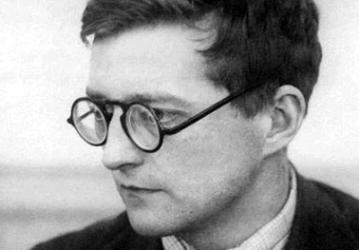On 17 September 1941, the composer, Dmitry Shostakovich, made a radio announcement in which he said, ‘Just an hour ago, I completed the score of two movements of my new, large symphonic work.’ This new work was his Seventh Symphony, later to be called the Leningrad.
Shostakovich was considered too famous to be so exposed to risk, so the city authorities tried to make the composer leave but, loyal to the city, he stayed. Working on his composition and volunteering for the People’s Militia, he stated, ‘Until now I have known only peaceful work. But now I am ready to take up arms.’ His good intentions were dashed by the military, rejected because of his poor eyesight. He was allowed instead to take his turn on fire warden duty. The American magazine, Time featured the composer on its cover, wearing a golden helmet and holding a fireman’s nozzle, with the caption, ‘Fireman Shostakovich’. Eventually, he was ordered to leave. On 1 October, with his wife and children and the manuscript of his score stuffed in his suitcase, he bid farewell to the city of his birth. While he was gone, his dog was eaten.

Dmitry Shostakovich
Evacuated to the town of Kuibyshev (modern-day Samara), 900 miles south-east of Leningrad, Shostakovich worked feverishly on the symphony while producing short works to entertain the troops on the front line, tunes with catchy titles, such as The Fearless Guards Regiment is on the Move. By the end of the year, the symphony was done. Dedicated to ‘our struggle against Fascism, to our coming victory and to my native city of Leningrad’, it received its world première, broadcast to the nation, in Kuibyshev on 5 March 1942, followed by a performance in Moscow three weeks later.
A microfilm of the score was smuggled out of the Soviet Union and flown to Teheran and from there to Europe, where conductors fought for the privilege of conducting the work. It was performed first in London, conducted by Sir Henry Wood, then in New York on 19 July, conducted by Arturo Toscanini. The symphony was an immediate hit and Shostakovich’s face appeared in newspapers and magazines all over the world.
Then came the decision to play the Seventh Symphony in Leningrad itself. It would be, according to Zhdanov, good for the city’s morale. A Soviet plane, dodging the German guns, delivered the score to Zhdanov. The city’s principle orchestra, the Philharmonic, had already been evacuated out of the city but the reserve orchestra, the Leningrad Radio Orchestra, was still available. Its conductor, 42-year-old Karl Eliasberg, was charged to reassemble his musicians. But of its 100 members, only 14 remained. The others had all died or been killed. Replacements had to be found. The call went out urging soldiers who could play an instrument to report for duty. The score, complex and mammoth, was seventy-five minutes long and involved a ninety-piece orchestra. Given the weakness of the musicians who had gathered for the first rehearsal in March 1942, Eliasberg knew the difficulty of the task that lay ahead. ‘Dear friends,’ he began, ‘we are weak but we must force ourselves to start work.’ And it was hard work – despite extra rations – many, especially the brass players, passed out with the effort of playing their instruments. Eliasberg was tough on his players – those who played badly or, worse, failed to turn up for the three-hour long rehearsals, were docked a bread ration. Through discipline and coaxing, Eliasberg got his skeletal orchestra to perform Shostakovich’s huge work. Only once during rehearsals did the orchestra have enough strength to play the whole work throughout – three days before the big event.
The date for the performance was fixed – 9 August 1942, a date set by the Nazis, a few months before, for a huge party in Leningrad’s Astoria hotel to celebrate their anticipated capture of the city. The invitations had already been printed. They were never sent out.
The Philharmonic Hall was packed – people came in their finest clothes, the city leaders and generals took their places. The musicians, despite the warm August temperature, wore coats and mittens. When the body is starving, it is continually cold. Outside, throughout the city, people gathered to listen at the loudspeakers. Hours earlier, Leonid Govorov, Leningrad’s military commander since April 1942, ordered a barrage of artillery onto the German lines to ensure their silence for at least enough time for the work to be performed without interruption. Loudspeakers, on full volume, pointed in the direction of the Germans – the city wanted the enemy to hear.
’This performance,’ announced Eliasberg in a pre-recorded introduction, ‘is witness to our spirit, our courage and readiness to fight. Listen, Comrades!’ And the city listened, as did the Germans nearby, and the whole world. It listened as the city of Leningrad reasserted its moral self.
At the end – silence. Then came the applause, a thunderous applause that lasted over an hour. People cheered and cried. They knew they had witnessed a momentous occasion. It was, as Eliasberg described later, the moment ‘we triumphed over the soulless Nazi war machine.’ Years after the war, Eliasberg met some Germans who had been sitting encamped in their trenches outside the city. On hearing the music, they told the conductor they had burst into tears, ‘Who are we bombing?’ they asked themselves. ‘We will never be able to take Leningrad because the people here are selfless.’
Later, Eliasberg and his orchestra were invited to a reception by Zhdanov where, laid out before them, was a huge banquet. They gorged themselves, only to be sick soon afterwards.